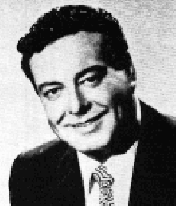Home · Listener's Guide · The Songs · Who's Who · Liner Notes · Selected Tracks · What's New · Search

Jackie Gleason
- Born Herbert John Gleason, 26 Feb 1916, Brooklyn, New York
- Died 24 June 1987, Miami, Florida
 Gleason started as a comedian, working on radio and in movies beginning in the late 1930s. He got a part on a very early TV series, "The Life of Riley," and then was given his own variety show, "Cavalcade of Stars," in 1949. Gleason introduced most of his
characters in skits on this show, including what was spun off as "The Honeymooners" in 1955.
Gleason started as a comedian, working on radio and in movies beginning in the late 1930s. He got a part on a very early TV series, "The Life of Riley," and then was given his own variety show, "Cavalcade of Stars," in 1949. Gleason introduced most of his
characters in skits on this show, including what was spun off as "The Honeymooners" in 1955.
Although Gleason could neither read or write music, he had an idea about recording music that combined popular songs with moody, string-laden orchestrations. He hired his own studio orchestra, pulled some orchestrators together, and began describing what he was looking for, occasionally picking out passages with one finger on the piano. He cut a deal with Capitol that put the risk of profit on his back, with the unheard-of break-even number of 60,000 copies sold. As it turned out, the album, Music for Lovers Only, sold over 500,000. Listeners liked how Gleason smoothed down the tunes, making them perfect background music for making out on the couch--but his TV popularity helped, too.
Gleason released over 20 albums between 1953 and 1969, all on Capitol. Many featured cornetist Bobby Hackett soloing off in a distance, as if in a fog, adding to the "moodiness" of the music. Hackett later remarked that "Jackie Gleason taught me to play," and it wasn't meant to be sarcastic. To go by the liner notes, such as the following, from Opiate D'Amour, you'd think a Gleason album would be over the top with syrupy strings:
Into this intensely romantic album, Jackie Gleason has decanted a tranquilizing potion as dreamily hypnotic as a warm breeze caressing a field of poppies.But the truth is that these are some of the most laid-back easy listening albums ever recorded. What Hackett was crediting was Gleason's sense of restraint, an often neglected attribute among musicians. All it takes to hear that is to play a Gleason track back-to-back with one by another big easy listening name, such as Mantovani. Instead of a big, upfront sound full of instrumentation, you notice the music is subtle, very much in the background. Gleason was consciously trying to create a mood (hence the more appropriate label, mood music).
Now, there was nothing subtle about the mood he was trying to create. It doesn't take two guesses to figure out what Music to Change Her Mind intended to change her mind about. Although it's never been verified, Gleason has been quoted as saying that when he liked to associate his music with a guy looking at a beautiful woman in a nightgown and thinking to himself, "Mmmm ... I want to come." You'll find no great climaxes on a Gleason album, though. To today's listener, the ultra-mellow sound makes it seem as if the goal was to get a woman to sleep with you, and I don't mean that to be a euphemism. It's no accident that Gleason holds the world's record for the slo-o-o-west version of "The Third Man Theme" with the track on Movie Themes for Lovers Only. He once said, "The only thing better than one of my songs is one of my songs with a glass of scotch."
Pete King arranged many of the early albums, with Billy May coming in on Velvet Brass. George Williams succeeded King and handled the arrangements through the end of the Gleason's recording career. Gleason employed top-notch jazz soloists, with frequent appearances by Pee Wee Erwin and Roy Eldridge, replacing Hackett after 1960, and saxophonist Charlie Ventura, Buddy Morrow on trombone, Milt Hinton on bass, and pianist Bernie Leighton. Gleason experimented with instrumentation occasionally--going so far as to add a sitar and Emil Richards dabbling on exotic percussion on The Now Sound for Today's Lovers, but more often with the theme and artwork of an album.
Capitol's 2 CD compilation, Romantic Moods of Jackie Gleason is probably the best introduction, and likely the only recording most listeners will need. For those who want to explore more, though, several albums are worth a search. Music, Martinis, and Memories is perhaps the best of his albums with Hackett, a perfect companion to a night of cocktails, cigarettes, and groping. Oooo! throws in an added ingredient of wordless vocals, by a chorus led by Artie Malvin. Riff Jazz and Rebound feature smaller combos and pleasant, if--surprise--unobtrusive, jazz numbers. And I like Velvet Brass, a fine set of tightly-orchestrated Billy May charts. On the other hand, while The Lonesome Echo is highly prized for its cover by Salvador Dali, its music is standard Gleason.
Although Gleason couldn't read music, he went beyond just advising arrangers and picking songs. He wrote the theme for "The Honeymooners" ("You're My Greatest Love") and "The Jackie Gleason Show," his variety series ("Melancholy Serenade"). And he did a fine job of capturing the bal musette school of Parisian street music in his score for his maudlin comedy, Gigot.
He stopped recording in 1969, but continued to appear on television and in films and manage a variety of ventures in the Miami area, until his death.
S p a c e A g e P o p M u s i c
Recordings
Courtesy of Tom Lowery
Jackie Gleason.-->
Home · Listener's Guide · The Songs · Who's Who · Liner Notes · Selected Tracks · What's New · Search
Email: editor@spaceagepop.com
© spaceagepop 2019. All rights reserved.